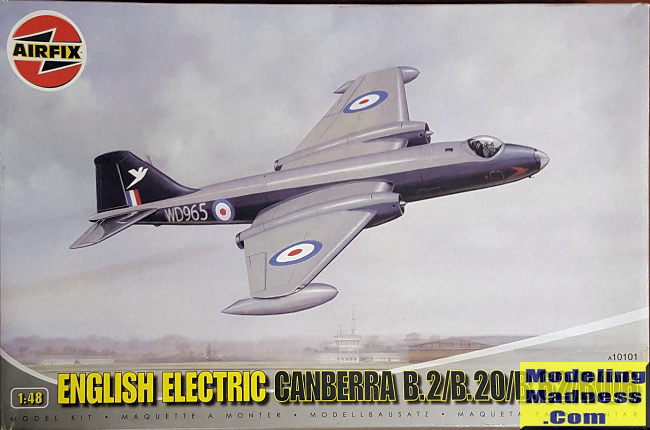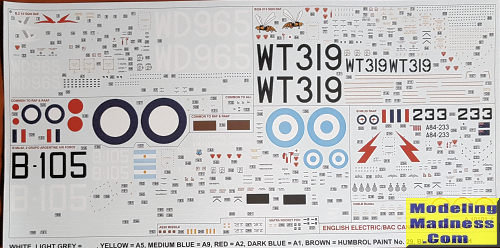
Airfix 1/48 Canberra B.2/20/62/B.(I)6
| KIT #: | A10101 |
| PRICE: | $35.00 'used' |
| DECALS: | Four options |
| REVIEWER: | Scott Van Aken |
| NOTES: | 2008 release |

| HISTORY |
The English Electric Canberra is a British first-generation jet powered medium bomber. It was developed by English Electric during the mid-to-late 1940s in response to a 1944 Air Ministry requirement for a successor to the wartime de Havilland Mosquito fast bomber. Among the performance requirements for the type was the demand for an outstanding high-altitude bombing capability and high speed. These were partly accomplished by making use of newly developed jet propulsion technology. When the Canberra was introduced to service with the Royal Air Force (RAF), the type's first operator, in May 1951, it became the service's first jet-powered bomber.
Throughout most of the 1950s, the Canberra could fly at a higher altitude than any other aircraft in the world. In 1957, a Canberra established a world altitude record of 70,310 feet (21,430 m). In February 1951, another Canberra set another world record when it became the first jet aircraft to make a non-stop transatlantic flight. Due to its ability to evade the early jet interceptor aircraft and its significant performance advancement over contemporary piston-engined bombers, the Canberra became a popular aircraft on the export market, being procured for service in the air forces of many nations both inside and outside of the Commonwealth of Nations. The type was also licence-produced in Australia by the Government Aircraft Factories and in the US by Martin as the B-57 Canberra. The latter produced both the slightly modified B-57A Canberra and the significantly updated B-57B.
In addition to being a tactical nuclear strike aircraft, the Canberra proved to be highly adaptable, serving in varied roles such as tactical bombing and photographic and electronic reconnaissance. Canberras served in the Suez Crisis, Vietnam War, Falklands War, Indo-Pakistani wars and numerous African conflicts. In several wars, each of the opposing sides had Canberras in their air forces.
The Canberra had a lengthy service life, serving for more than 50 years with some operators. In June 2006, the RAF retired the last of its Canberras, 57 years after its first flight. Three of the Martin B-57 variant remain in service, performing meteorological and reentry tracking work for NASA, as well as providing electronic communication (Battlefield Airborne Communications Node or BACN) testing for deployment to Afghanistan.
| THE KIT |
When Airfix released the Canberra back in 2008, they also released the B-57, PR.9 and B(I).8 kits so that covered the type pretty well. This kit is the initial one produced and comes in a very large box that contains not only the kit but an equally large decal sheet. The cockpit is fairly well done and you are provided with crew members. There are several update cockpit sets for this kit, but to be honest, you won't see much of any cockpit work you put into as the cockpits of the time were matte black. After installing the bomb bay and finding a place for 100grams of nose weight, the fuselage halves are closed up.
Next are the wings and you open pylon slots if your version has underwing pylons. Ailerons are separate and must be assembled. Later you can pose the flaps lowered as an option. Typical of 'in wing' aircraft, there are separate intake and exhaust assemblies. You are also provided separate rudder and elevators. Landing gear are well done and it is not surprising that there is no 'in flight' option provided. What option is provided is open or closed bomb bay doors and a bombardier's door that you can have open if you wish.
There are several weapons options. One is for iron bombs to fit in the bomb bay. There are also bombs for the outer wing pylons along with rocket pods and what look like Martel anti-ship missiles. These are all dependent on what version you are building. For the interdictor version, a belly gun pack is provided.
 Instructions are typical of Airfix of the time and provide
only Humbrol paint numbers during construction. This changes for the camouflage
sheet which is in full color. There are markings for four aircraft, most in
grey/green over light grey. The initial option is the exception being the box
art plane from 10 Squadron RAF. The B.20 is 2 Squadron RAAF while the B.62 is an
Argentine aircraft. The B(I).6 is from 213 Squadron RAF. The huge decal sheet is
nicely printed and should provide no issues.
Instructions are typical of Airfix of the time and provide
only Humbrol paint numbers during construction. This changes for the camouflage
sheet which is in full color. There are markings for four aircraft, most in
grey/green over light grey. The initial option is the exception being the box
art plane from 10 Squadron RAF. The B.20 is 2 Squadron RAAF while the B.62 is an
Argentine aircraft. The B(I).6 is from 213 Squadron RAF. The huge decal sheet is
nicely printed and should provide no issues.
| CONCLUSIONS |
When done, the model will occupy much space on your shelf. Despite its size, it appears that it will be a straight-forward build with no issues. Be sure to stock up on paint as this one will take a lot of it. This kit has recently been reissued, but only has markings for two RAF units.
| REFERENCES |
https://en.wikipedia.org/wiki/English_Electric_Canberra
November 2020 Copyright ModelingMadness.com. All rights
reserved. If you would like your product reviewed fairly and fairly quickly, please contact the editor or see other details in the
Note to
Contributors. Back to the Main Page
Back to the Review
Index Page
Back to the Previews Index Page